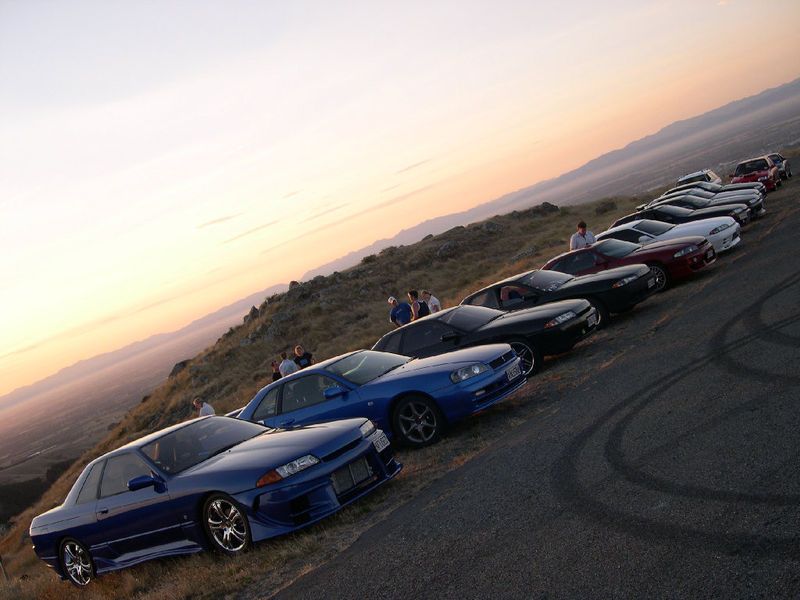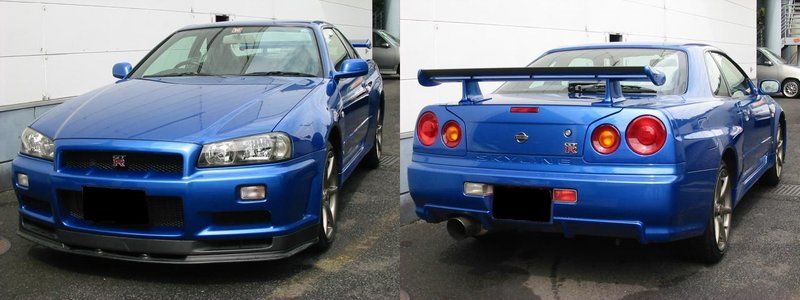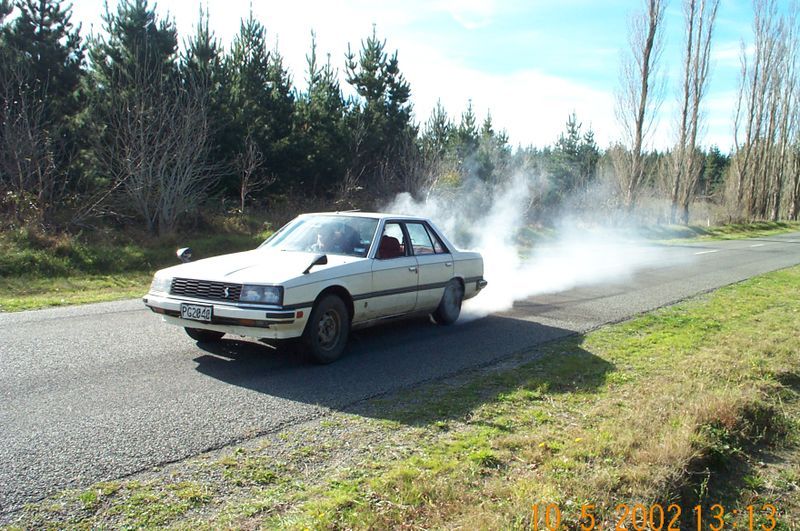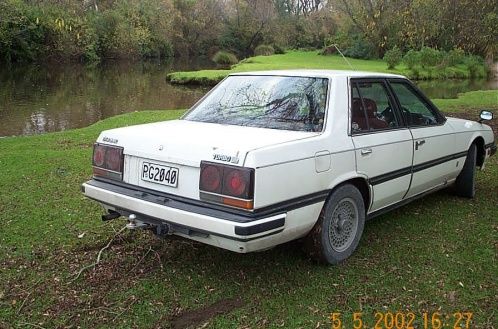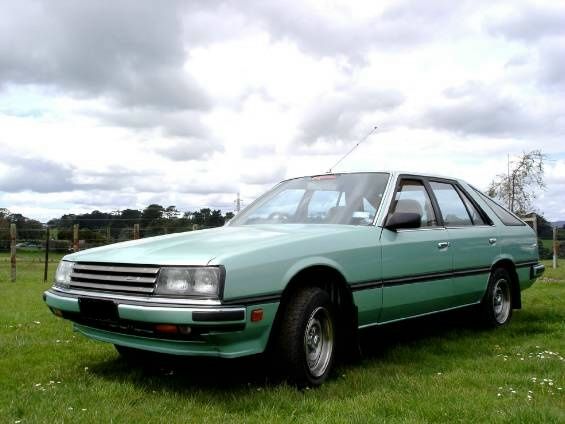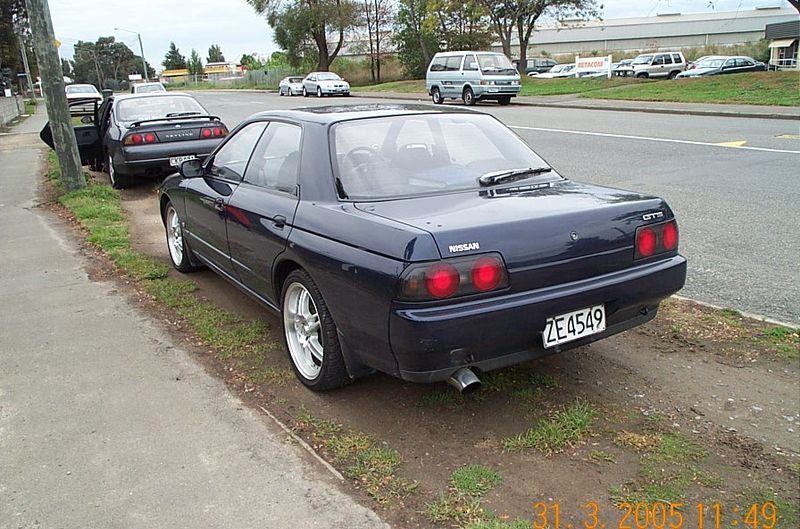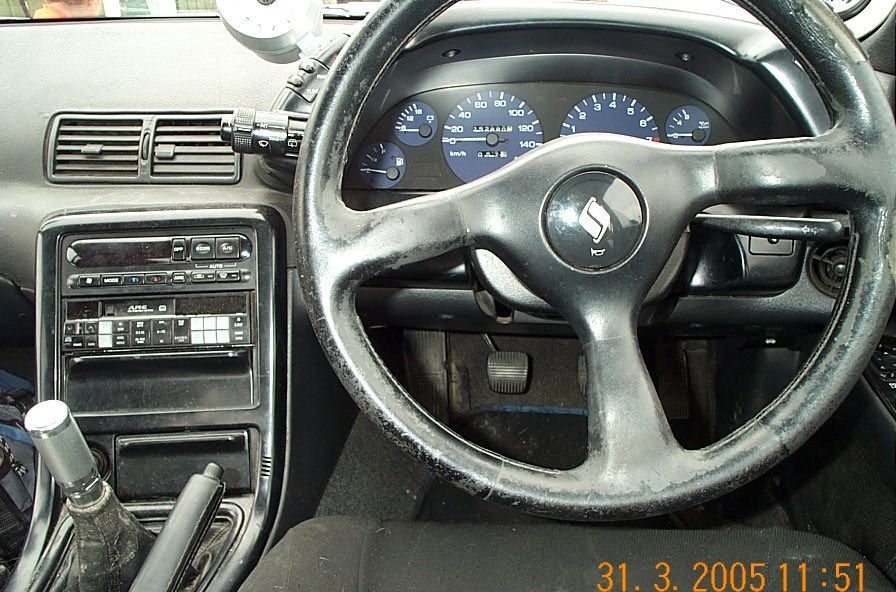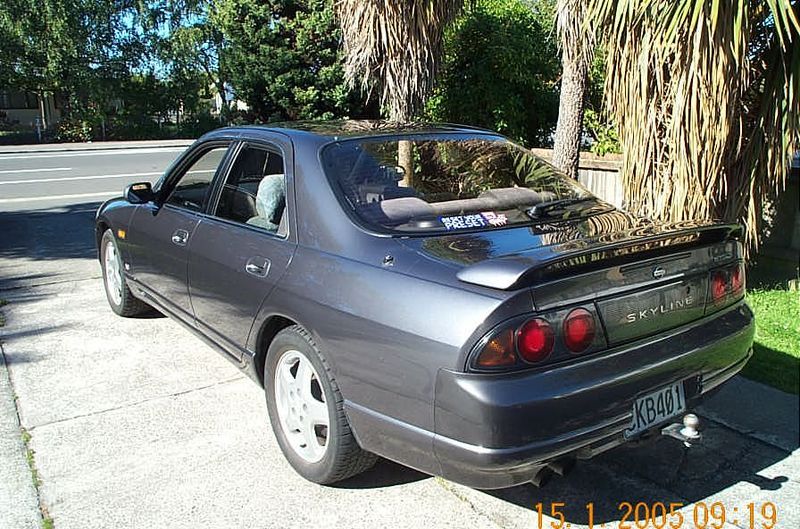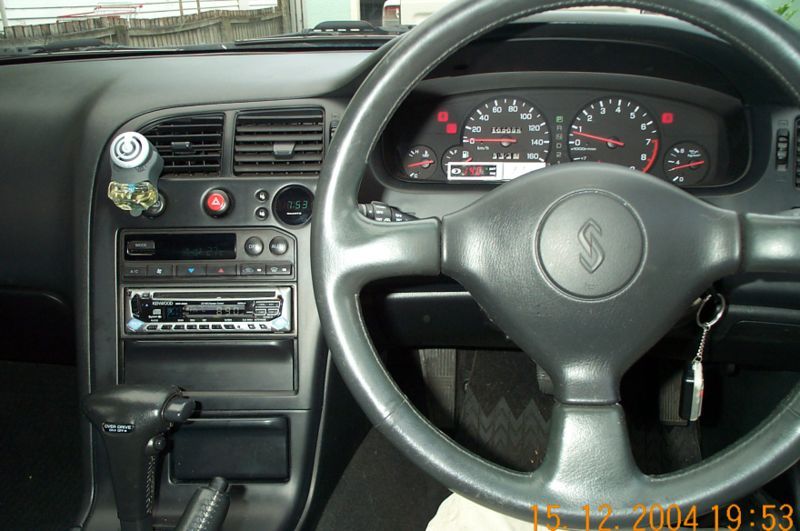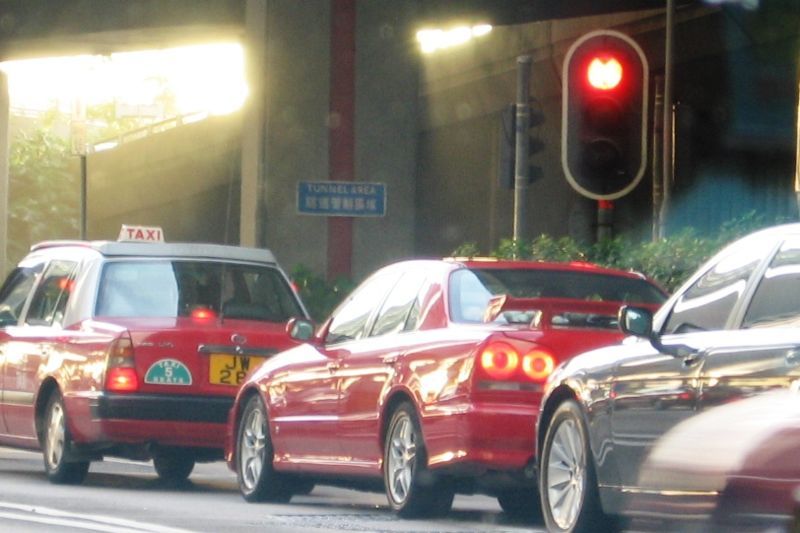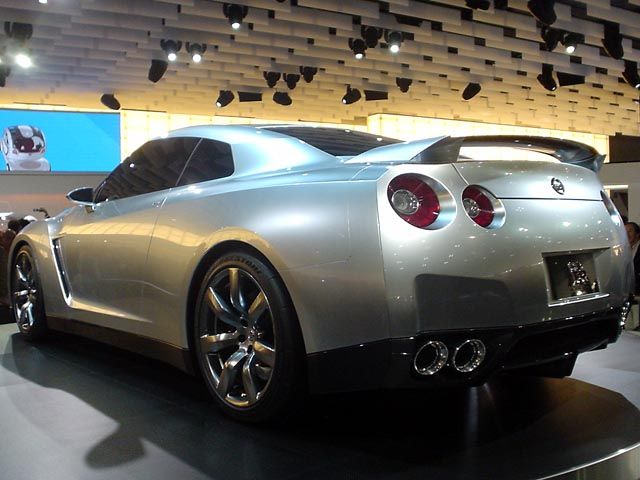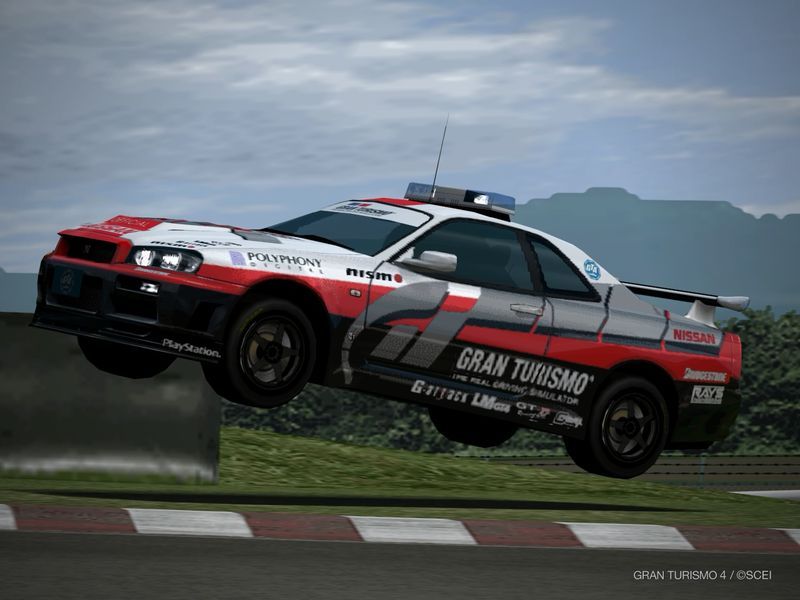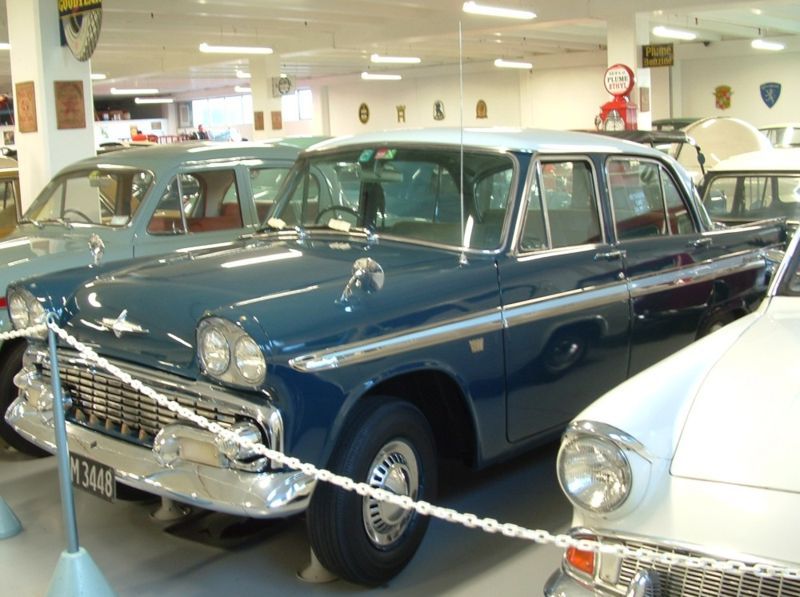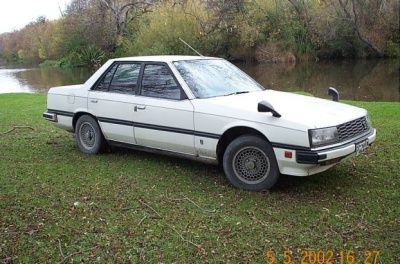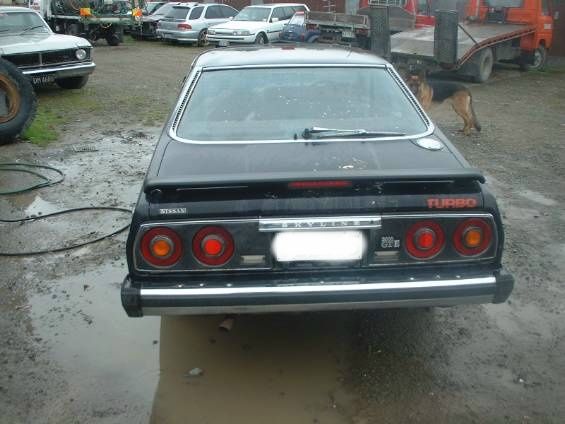The Nissan Skyline is an intermediate-size automobile range sold in Japan and other countries. It is available in either coupe or sedan body styles. The current Skyline is sold in North America, South Korea, Taiwan, and the Middle East as the Infiniti G35.
1957 - 2006 Nissan Skyline
- Make: Array
- Model: 1957 - 2006 Nissan Skyline
- Engine/Motor: 2.3L Inline-4
- Horsepower: 240@0
- Transmission: 5-Speed Automatic
- [do not use] Vehicle Model: Array
ALSI-1
The first Skyline was introduced in April 1957, under the Prince marque, and was marketed as a luxury car. It featured a 1.5 L (1482 cc) GA-4 engine producing 44 kW (60 hp). It used a de Dion tube rear suspension and was capable of 140 km/h (87 mph). The car weighed around 1300 kg. Prince Skylines were produced as four door sedans and five door station wagons.
The Skyline also spawned pickup truck and van lines called the "Prince Skyway."
ALSI-2
The Skyline was updated with quad headlights for 1957. This model was powered by a slightly altered 1.5 L engine known as the GA30 OHV (1484 cc) producing about 60 hp @ 4400 rpm and was produced through 1961. This is the first four round headlight car design in Japan)
S50 or BLSID
In 1961 Fuji Precision Industries changed its name to Prince after the 1954 merger, and the S50 series was launched. This was the second generation car, and became one of the more desirable cars in Japan. It was powered by the G-1 engine, a 70 hp (52 kW) version of the old GA-4. An 1862 cc engine was also available, delivering 91 hp.
In 1962, this model was restyled as the S21S series.
The S50 was further developed with new styling for 1963, and was sold in some markets with an A150 designation.
In 1966, Nissan and Prince merged and the S50 also appeared with Nissan Skyline badging. This model lasted in production through 1967.
BLRA-3
The Skyline Sport featured hand-built Michelotti bodies in stylish coupe and convertible versions. These cars used the 1.9 L (1862 cc) GB-30 engine, producing 83 hp (61 kW). Only a few were built.
S54
Prince created a racing GT Skyline In May 1964. It was based on the S54 and used the larger 6-cylinder G-7 engine from the Gloria S40, though the engine bay needed an 8" extension welded in to fit the straight six. When it entered the 2nd Japanese Grand prix they hoped to win the GT-II class. Competitive against the Porsche 904, the Skyline managed 2nd through to 6th places.
Largely due to the success of their race vehicle, the Prince 2000GT (also called GT-A, GT-B, S54A and S54B) was released to the Japanese market. There were two versions produced:
-
S54A - 1988 cc G-7 single-carb I6, 106 hp (78 kW)
-
S54B - 1988 cc G-7 triple-carb I6, 127 hp (94 kW)
The B model featured three Weber 40DCOE-18 carburetors, a limited slip differential, 5-speed manual transmission, and power brakes. Both the B and A used front disc brakes with dual pistons.
S57
The S50 Skyline was updated to become the S57 in 1967. It used a Nissan engine, the OHC 1.5 L (1487 cc) G15. At 88 hp (66 kW), it was the most-powerful engine in the Japanese 1500 cc class.
C10
The C10 series of 1968, probably developed by Prince, got Nissan badging. There was no Prince equivalent on the market. It used Nissan's 1.5 L OHC G15 I4 like the S57. A 1.8 L G18 version was also available.
A station wagon variant was offered in this generation. A hardtop coupe was introduced in 1970.
2000GT
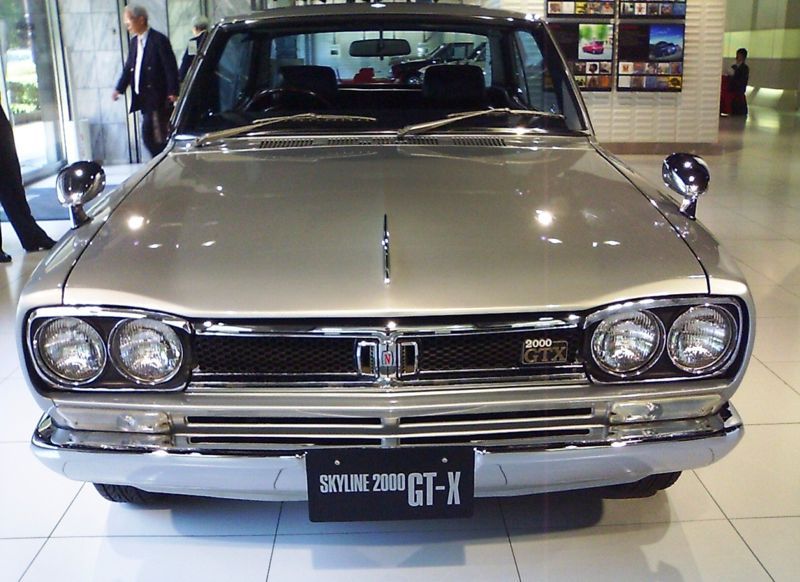
The following year, the GC10 2000GT received a 2.0 L (1998 cc) L20 I6 engine. The chassis was already designed to receive a straight six, to avoid the S54 extension problem. 105 hp (78 kW) was available from this new engine.
GT-R
The first GT-R Skyline appeared in February 1969. Called the PGC-10 (KPGC-10 for later coupe version) internally and Hakosuka (ハコスカ) by fans. Hako (ハコ) means Box in Japanese, and suka(スカ) means Skyline (スカイライン; Sukairain). It used the 2.0 L (1998 cc) S20 I6. This new engine produced 160 hp (119 kW), equal to the best sports cars of the time, and was similar to the GR8 engine used in the Nissan R380 racing car.
The GT-R began as a sedan, but a 2-door coupe version was introduced in March of 1971. The cars were stripped of unnecessary equipment to be as light as possible for racing, and the cars performed well at the track. The sedan racked up 33 victories in less than two years, and the coupe stretched this to 50 through 1972.
The KPGC-10's main circuit rival was the Mazda RX-3. By mid-1972 the RX-3 had surpassed the GT-R, ending the winning streak. The GT-R was also a favorite of reckless street racers who roamed the streets at night at that time.
It is claimed that the art of drifting began among Japanese racers when they purposely engaged their emergency brakes as a way to counter understeer on their GT-Rs. One such driver who was known for this was the Drift King Keiichi Tsuchiya.
C110
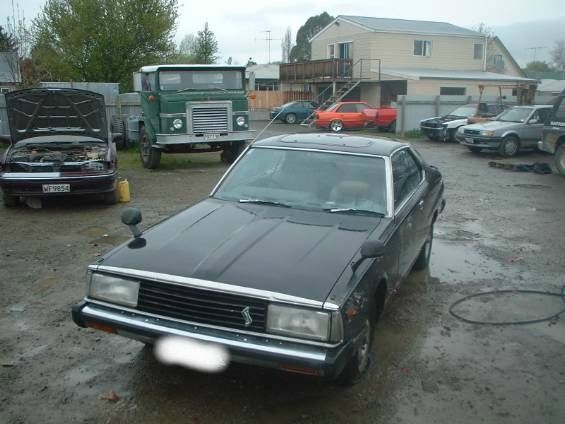
The C110 generation was produced from 1972 through 1977. There were four versions of the car:
-
1600GT - 1.6 L G16 I4
-
1800GT - 1.8 L G18 I4
-
2000GT-X - 2.0 L L20 I6, 130 hp (96 kW)
-
2000GT-R - 2.0 L S20 I6, 160 hp (118 kW)
For export in the 1970s, the C110 and GC110 Skyline was sold as the Datsun K-series, with models such as the Datsun 160K, 180K and 240K.
The body styles were, once again, four-door sedan, two-door hardtop coupe, and five-door station wagon. The C110 was fussier in its styling than its predecessor. This was the first version to feature the round rear lights typical of later Skyline designs.
The C110 Skyline was better known as the "Ken & Mary" or "Kenmeri" (ケンメリ) Skyline, stemming from the advertisement campaign in Japan at the time which featured a young couple (Ken and Mary) who relaxed and enjoyed the countryside in Ken and Mary's Skyline (ケンとメリーのスカイライン). The ads were highly successful and perhaps as a result the C110 was a sold in very large numbers in Japan. It sold just as well in Australia, though few survive today. There, the 240K was about the same price as a Ford Falcon GT or BMW 5 series, around $5000
GT-R
The Nissan Skyline GT-R hardtop arrived in September 1972 but only lasted until March 1973, when Nissan ceased production. The oil crisis saw many people preferring economy cars and high-performance sports cars were looked down upon. Nissan pulled out of Motor Racing, so there was no purpose to the GT-R. It was not officially exported anywhere, although Nissan contemplated exporting to Australia. Only 197 KPGC110 GT-Rs were ever sold in Japan, through specialist Nissan Performance shops (before it was called NISMO). This was the last GT-R for 16 years until the BNR32 in 1989.
GT-R
The succeeding C211 and GC211 of 1977 continued to split the Skyline range into basic and six-cylinder models, the latter with a longer front end. This line continued through 1981. The Datsun 240K/280K and 240C/280C variants continued for export.
A rare variant would be the wagon version, which had a unique styling treatment behind the rear doors, of a much smaller window than usual between the C and D pillars.
The GT-ES replaced the GT-R with a turbocharged engine, the L20ET. This was the first turbo engine to power a Japanese production vehicle. One notable aspect of the turbo versions was that they were not intercooled and there was no form of blowoff valve, only an emergency pressure release valve.
Models:
-
1600TI - 1.6 L L16 I6
-
1800TI - 1.8 L L18 I6
-
2000GT - 2.0 L L20 I6, 130 hp (96 kW)
-
2000GT-EX - 2.0 L L20ET turbo I6. 140 hp (103 kW)
-----
C211
The names were brought into line with the home U.S. and Japanese markets with the launch of the FJR30 series in 1981, which was built on a C31 Laurel platform. The FJR30 was available as a four door sedans, a two door coupe, a 2800 cc diesel (4 door sedan only), a four door hatchback version and a 4 door wagon version. The wagon version was the ugly ducking of the range with different lights and no turbo or six cylinder versions available; it more closely resembled a Nissan Sunny than Skyline. In all, there were 26 variations. All versions with the exception of the wagon were usually fitted with the four round tail lights that had become a regular feature to the Skylines' design. The 2 door version had pillar-less doors and the unusual feature of electric roll-down quarter windows for the rear seat passengers. The 4 door had traditional framed door windows.
Models:
-
1800TI - 1.8 L Z18 SOHC I4, 105 hp (77 kW)
-
2000GT/EX - 2.0 L L20E SOHC I6
-
2800GT - 2.8 L L28E SOHC I6
-
2000GT-EX - 2.0 L L20ET turbo I6, 140 hp (103 kW)
-
RS - 2.0 L FJ20E DOHC I4, 150 hp (110 kW)
-
RS-X - 2.0 L FJ20ET DOHC turbo I4, 190 to 205 hp (140 to 151 kW)
-
2000GT-ES Paul Newman Version - 2.0 L L20ET turbo I6, 140 hp (103 kW)
R30
The 1983 R30 version now sported four wheel disc brakes as standard (optional until this time) and various engines, the best models being the twin cam 4 cylinder turbo FJ20 or the single cam 6 cylinder turbo L20ET. Although making about the same power, the FJ-engined version was more of a racer without as many heavy extras on the car (electric windows, air conditioning, etc). Some of the top spec GT-ES models featured adjustable suspension dampers that could be adjusted while driving, this was a first for mass produced JDM vehicles. Nissan Glorias and Laurels also used the LT series engines as well as some diesel (Laurel only) variants. In Japan there are still dedicated "one make" drag racing for the FJ20 powered FJR30 Skylines.
R31
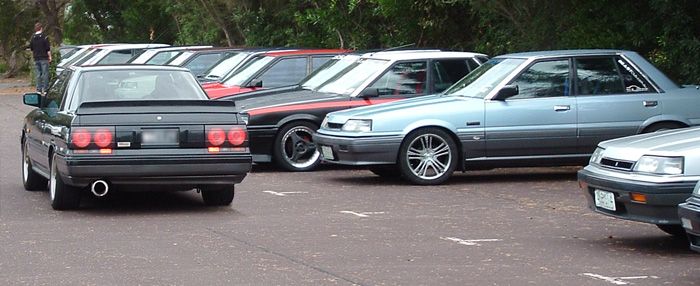
The HR31 Skyline of 1986 was a natural evolution on the HR30 shape. The design was slightly larger and squarer than previous Skylines.
The R31 Skyline was also produced in Australia, with a 3.0 L motor (RB30E) available in sedan or wagon form, as well as a four-cylinder version called the Nissan Pintara. The wagon had the same front style as the coupe and sedan—the only difference being that it lacked the four round brake lights that had been a consistent element of Skyline design. These cars were manufactured in Australia due to the heavy import laws which made it expensive to bring cars into Australia.
29,305 R31 Skylines were also manufactured and sold in South Africa in 4-door sedan form between 1987 and 1992. These were the last Skylines seen in South Africa. Power came from either the RB30E 3.0 straight-6 motor, RB20E 2.0 straight-6 motor or the CA20S 4-cylinder power plant.
The R31 Skyline introduced many new technologies and features. The HR31 was the first Skyline to be equipped with the new RB-series of engines. The R31 RB engines are often referred to as "Red Top" engines because of the red cam covers. There were three variants. The earliest series of DOHC RB engines used the NICS (Nissan Induction Control System) injection system with 12 very small intake runners, and a butterly system to divide the intake ports in half for better low RPM performance. Later versions used ECCS (Electronically Concentrated Control System) engine management, discarded the twelve tiny runners for six much larger ones (though they retained twelve ports on the head, so there was a splitter plate), and received a slightly larger turbocharger. The ultimate version of these motors was the RB20DET-R Group A homologation motor, found in the HR31 Skyline GTS-R (800 units built), which incorporated a much larger turbocharger on a stainless steel exhaust manifold, as well as a much larger front mounted intercooler boosting power to 210 ps (racing versions made 460 hp in Group A trim). Nissan's RD28, a 2.8 straight-6 engine, introduced Diesel-power to the line-up. Another technological first for the R31 was the introduction of Nissan's proprietary 4-wheel steering system, dubbed HICAS (High Capacity Active Steering). The R31 series were also the only models in the Skyline family to feature a 4-door hardtop variation. These models were generally badged as the Passage GT.
Models: 'Japan'
-
1800I - 1.8 L CA18(i) SOHC I4, 100 hp (75 kW)
-
Passage GT - 2.0 L RB20DE DOHC I6, 155 hp (114 kW)
-
Passage GT - 2.0 L RB20DET DOHC turbo I6, 180 hp (132 kW)
-
GTS - 2.0 L RB20DE DOHC I6, 155 hp (114 kW)
-
GTS-X - 2.0 L RB20DET DOHC turbo I6, 190 hp (140 kW)
-
GTS-R - 2.0 L RB20DET-R DOHC turbo I6, 210 hp (154 kW)
'Australia'
-
Pintara - 2.0 L CA20E I4, 102 hp (76 kW)
-
GX, Executive, GXE, Silhouette, Ti - 3.0 L RB30E SOHC I6, 155 hp (114 kW)
-
GTS1 - 3.0 L RB30E SOHC I6, 176 hp (130 kW)
-
GTS2 - 3.0 L RB30E SOHC I6, 190 hp (140 kW)
'South Africa'
-
2.0GL, 2.0GLE - 2.0 L CA20S I4, 106 hp (78 kW)
-
2.0SGLi - 2.0 L RB20E SOHC I6, 115 hp (85 kW)
-
3.0SGLi - 3.0 L RB30E SOHC I6, 171 hp (126 kW)
R32
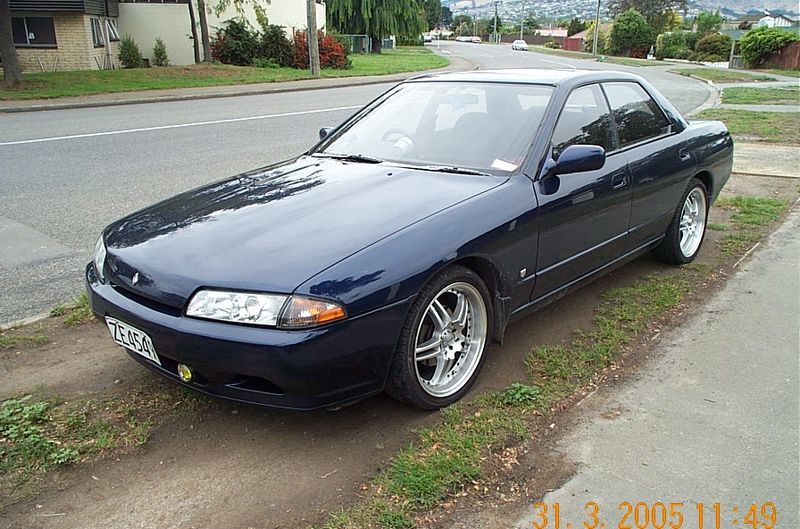
The HR32 Skyline debuted in May 1989. It was available as either a hardtop 2-door or 4-door sedan/saloon. It featured several versions of the RB-series straight-6 engines, which had improved heads (the twelve port inlet was gone) and used the ECCS (Electronically Concentrated Control System) injection system. Also available were an 1800 cc 4 cylinder GXi model. Most models had HICAS four wheel steering, with the rear wheels being hydraulically linked to the front steering. The 2.5 liter version became one of the first cars made in Japan to feature a 5 speed automatic transmission. All 2 liter turbo and non turbo versions with automatic transmissions were 4 speed.
R32 Models:
-
GXi Type-X - 1.8 L CA18i I4, 91 hp (67 kW)
-
GTE Type-X - 2.0 L RB20E I6, 125 hp (93 kW)
-
GTS Type-X, S, J - 2.0 L RB20DE I6 155 hp (115 kW) (most common)
-
GTS-25 Type-X, S, XG - 2.5 L RB25DE DOHC I6, 180 hp (132 kW)
-
GTS-t Type-M - 2.0 L RB20DET turbo I6, 212 hp (156 kW)
-
GTS-4 - 2.0 L RB20DET turbo I6, 212 hp (156 kW) 4WD
-
GT-R - 2.6 L RB26DETT twin-turbo I6, 280 hp (206 kW) 4WD also NISMO, VSPEC and VSPECII variants
Also based on the Skyline platform were the A31 Cefiro and C33 Laurel. All 3 cars are very popular in Japan (and other countries to which they are imported secondhand) for drifting. In Japan, the CA18i engine in the GXi is sometimes swapped for an SR20DET (4 cylinder turbo), resulting in a lighter and better-balanced car than the factory six-cylinder turbo models.
GT-R
The GT-R returned with twin ceramic turbochargers, all-wheel steering, all wheel drive and 280 hp (206 kW) at 6800 rpm. The RB26DETT engine actually produced ~320 hp, but it was unstated due to the Japanese car makers' "gentlemen's agreement" not to exceed 206 kW (276 hp). The engine was designed for ~500 hp in racing trim, and then muzzled by the exhaust, boost restriction, and ECU. The electronic boost control had a small physical restriction in the control lines. It was marked in yellow so the new owner could remove it and enjoy a safe factory boost increase. The GT-R had Super HICAS, a more advanced computer controlled four wheel steering system using electric actuators.
The GT-R had a much larger intercooler, larger brakes, and aluminum front guards and bonnet. Other distinguishing features include flared front and rear wheel arches. More supportive seats were fitted, and the turbo boost gauge and digital clock were removed from inside the instrument cluster. The clock was replaced with a torque meter that indicated how much torque was being delivered to the front wheels (0%-50%). Oil temp, voltage and turbo boost gauges were fitted below the climate control.
The Porsche 959 was Nissan's target when designing the GT-R. The chief engineer, Naganori Itoh, intended to use the car for Group A racing, so the design specification was drawn up in conjunction with a copy of the Group A rules. The Nordschleife production car record at the time of development was 8'45" - set by a Porsche 944. Nissan test driver Hiroyoshi Katoh reset the record with a time of 8'20". Best Motoring managed 8'22"38.
This model soon earned the name Godzilla, for its track performance. The R32 GT-R dominated JTCC, winning 29 races from 29 starts, taking the series title every year from 1989-1993. It took 50 races from 50 starts from 1991-1997 (latterly R33) in the N1 Super Taikyu. The R32 GT-R was introduced in the Australian Bathurst 1000 touring-car race to compete against Holden and Ford V8 saloons, winning in 1991 & 1992. However, the GT-R's success sounded the death knell of Group A Touring Car racing; with the formula being scrapped soon after. JTCC was similarly blighted by the R32 GT-R, and splintered soon after, leading to the switch to the Supertouring category and also indirectly to the GT500 category of today.
When originally designed, the homologation rulebook mandated 16" wheels, so that's what the GT-R got. This limited the size of the brakes, and the Nissan four pots weren't really up to competition use. A later change in rules allowed 17" wheels, so in February 1993 the GT-R V-spec (for Victory) emerged wearing 17" BBS mesh wheels covering larger Brembo brakes. The clutch actuation changed from a push to a pull system, and the rear diff became active. A year later the V-Spec II appeared with a new sticker and wider tires.
R33
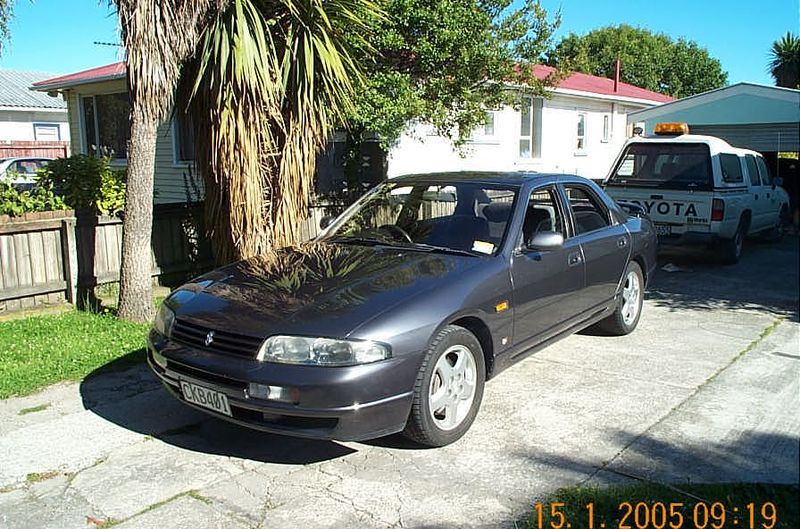
The R33 Skyline was introduced in August 1993. Slightly heavier than the R32, and available as a 2 and 4 door, all models now used a 6-cylinder engine. Nissan took the unusual step of down grading the GTS model to have only the RB20E, while the twin-cam of the R32 GTS was discontinued along with the 2.0 L turbo RB20DET. As with the R32, all auto transmissions on the 2.5 liter non turbo models were 5 speed, all 2 liter and turbo 2.5 liter automatic models were equipped with a 4 speed auto transmission.
Some models came equipped with a new version of the HICAS 4-wheel steering system called Super HICAS. This computer controlled system was first used on the R32 GTR. Super HICAS used electric actuators to steer the rear, as opposed to the hydraulic HICAS.
As an option, an active limited slip differential was available instead of the standard viscous LSD. This new unit locked the rear differential if it detected that traction was lost by one of the wheels. A light on the dash also lit up if the LSD engaged. Active LSD came standard on all V-spec R33 GT-R Skylines.
The RB25DE and RB25DET engines also became equipped with NVCS (variable inlet cam phasing). NVCS equipped RBs have a bulge on the front of the cam cover. To celebrate their 40th anniversary, Nissan introduced a very rare 4 door GT-R. Two versions of the 4-door GT-R were available from Nissan's subsidiaries: the first was produced by Autech, and the second was a joint Autech/Nismo project.
A R33 based wagon was released in September 1996, called the Stagea. It had a different body style than the R33 and R34 and (with the exception of the RS FOUR & Autech variants) was only available with an automatic transmission. A common modification on the Stagea is to fit it with an R34 skyline front, in effect making a 4 door R34 wagon. The Stagea is the only four wheel drive manual transmission Nissan on the R33 platform with the RB25DET engine. Presumably, a 5 speed 4WD Skyline equipped with an RB25DET would have been too close in performance to the much more expensive GT-R. There was also an Autech Stagea, the 260RS released with full GT-R running gear, the RB26DETT engine, body kit, 17" BBS style alloys, GT-R instrumentation, and manual transmission.
R33 models:
-
HR33 GTS - 2.0 L RB20E SOHC I6, 130 PS (96 kW)
-
ER33 GTS25 - 2.5 L RB25DE DOHC I6, 190 PS (140 kW)
-
ENR33 GTS-4 - 2.5 L RB25DE DOHC I6, 190 PS (140 kW) 4WD
-
ECR33 GTS25T - 2.5 L RB25DET DOHC turbo I6, 255 PS (188 kW)
1996
The R33 Skyline (Series 2) continued the concepts introduced in the R32. Driver’s airbags became standard in 1996 as they had been only an option up until this time, passenger side airbags remained an option. The ignition system was also changed, with the ignition module no longer located on the cam covers and was instead replaced by improved ignition coils and ECU. The turbo was also given a nylon compressor wheel. Throughout the time the R33 was produced there were quite a number of different styled lights and bodykits fitted, the actual body/chassis underwent no changes. Among the cosmetic changes in the series 2 were, the headlights which tapered down more towards the grill and were fitted with improved reflectors, the grill (which was longer on the Series 1), the bonnet which had a re-shaped leading edge to fit the new lights and front bumper changing shape in the smallest amount to match the lower edge of the new headlights. The R33 ceased production in March 1998 with the 40th Anniversary R33 SII.
GT-R
The BCNR33 GT-R version also had the same RB26DETT engine that the BNR32 was equipped with, although torque had been improved, due to changes in the turbo compressor aerodynamics, turbo dump pipe, and intercooler. The turbo core changed from a sleeve bearing to a ball bearing, but the turbine itself remained ceramic, except on N1 turbos (steel turbine, sleeve bearing). From the R33 onward, all GT-Rs received Brembo brakes. 1995 saw the GT-R get an improved version of the RB26DETT, the ATTESA-ETS all wheel drive system, and Super HICAS all-wheel steering. A limited edition model was created in 1996, called the NISMO 400R, that produced 400 hp (298 kW). The R33 GT-R set the production car lap record for the Nordschleife with an official time of 8'01"86, and several sub eight minute unofficial times. Other manufacturers had caught up since the R32 was released, and the R33 never dominated motorsport to the extent of the R32.
-
BCNR33 GT-R - 2.6 L RB26DETT DOHC twin-turbo I6, 305 PS (224 kW) (advertised as 280 PS) 4WD
-
GT-R LM - 2.6 L RB26DETT DOHC twin-turbo I6, 305 PS (224 kW) FR
-
400R - 2.8 L RBX-GT2 DOHC twin-turbo I6, 400 PS (294 kW) 4WD
-----
R34
In May 1998 the HR/ER/ENR34 addressed many of the concerns over the change from the R32 to the R33, with more emphasis on spottiness. The RB20E engine was discontinued in the R34 base model (GT) and the RB20DE reintroduced after last being used in the R32 Skyline. The R34 GT powered by the RB20DE and 5 speed gearbox became the most fuel efficient straight six Skyline to date of any shape. The 5 speed automatic transmission available on some models in the previous 2 shapes was discontinued. In its place Nissan produced a 4 speed tip-tronic transmission for all of the automatic versions.
Models:
-
R34GT - 2.0 L RB20DE I6, 140 hp (103 kW)
-
25GT-V - 2.5 L RB25DE I6, 193 hp (142 kW)
-
25GT/25GT-X - 2.5 L RB25DE I6, 193 hp (142 kW)
-
25GT-t - 2.5 L RB25DET turbo I6, 280 hp (206 kW)
GT-R
The GT-R reappeared in 1999, with a revised chassis and other updates. The stronger block from the R33 N1 GT-R was used on all R34 GT-Rs. The standard R34 GT-R turbos changed to a steel turbine. The R34 N1 turbos received a ball bearing core. Both had a higher compressor A/R ratio. A heavier stronger six speed Getrag gearbox was used. The head casting and the camshafts were significantly revised, and incompatible with earlier RB26DETTs. The dump pipe and intercooler were also improved. The BNR34 GT-R may well have been the last high performance Nissan to wear the Skyline badge.
Models:
-
GT-R - 2.6 L RB26DETT twin-turbo I6, 332 PS (244 kW) (advertised as 280 PS)
-
GT-R V-Spec - Additional aero parts, brake ventilation ducts, diffuser.
-
GT-R V-Spec II - As above + carbon fibre bonnet with NACA duct.
-
GT-R N1 - Blueprinted N1 motor, no A/C, no stereo, no rear wiper, basic interior trim. (only 45 made.)
-
GT-R M-Spec - Leather interior, softer suspension with "Ripple Control" dampers, heated seats.
-
GT-R V-Spec II Nür - As above V-Spec II + N1 motor, 300 km/h speedo. (Only 750 made.)
-
GT-R M-Spec Nür - As above M-Spec + N1 motor, 300 km/h speedo. (Only 250 made.)
-
GT-R Z-tune Z1 and Z2 (Nismo variant)
-
GT-R R-tune (Nismo variant)
-
GT-R S-tune (Nismo variant)
V35
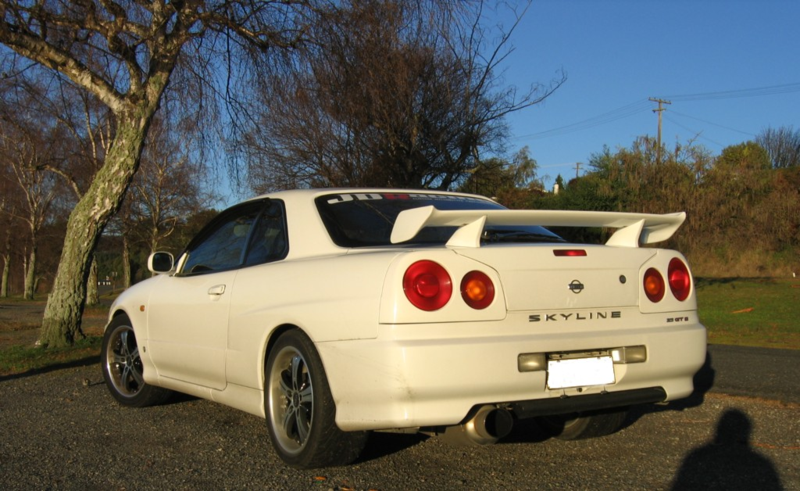
The 11th generation (V35) Nissan Skyline, introduced in June 2001, is based on Nissan's FM platform, which is shared with the 350Z. The Nissan Skyline uses a front-midship engine (VQ35DE), rear-wheel drive layout (all-wheel drive is available for the sedan) to achieve a 52%/48% weight distribution. The V35 also marks the first generation of Skyline made for export to the United States. There it is sold under the company's luxury brand, Infiniti, as the Infiniti G35.
The V35 marks a major turning point for the Skyline. There is no straight 6, no turbo variant, and to date no GT-R variant. Nissan put a slightly more powerful VQ35DE in the 350Z, and although the Skyline & the 350Z share the same platform, the 350Z has additional bracing, underbody aero parts, and weighs 100 kg less. Keiichi Tsuchiya said of the V35 "This is a Cefiro!". Most Japanese tuners have studiously ignored the V35 Skyline, the 2006 Tsukuba Super Lap Battle had not a single V35 entrant. Tuners such as Mines, Amuse, Hosaka, Garage Defend, M Speed, Nagisa, MCR, HKS, & Top Secret continue developing R32-R34 GT-Rs. Top Secret did tune a V35, but they replaced the VQ35DE with a VK45DE V8 Twin Turbo. Signal USA entered a V35 in Formula D, replacing the VQ35DE with an SR20DET. In contrast, US shops such as VRT have had success with forced induction VQ35DEs as seen in their track footage. Sites such as 6mt.net, G35Frenzy.com, and G35Driver.com have increased the popularity of tuned V35s.
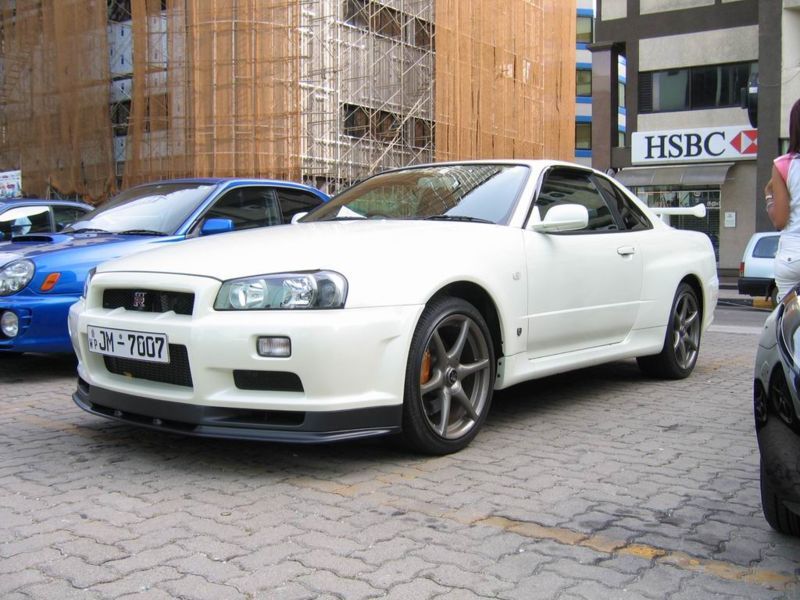
The next generation
During the 2001 Tokyo Motor Show, Nissan showed the Nissan GT-R "the 35th Tokyo Motor Show" Concept (with the Skyline moniker noticeably absent) showing the design direction for a future GT-R. In 2003 then Nissan president Carlos Ghosn announced that Nissan would release the new GT-R, probably as a 2007 model and would do so all over the world and not just in Japan and select right-hand drive markets (Britain and New Zealand). Meanwhile, in tracks around the world, most notably the Nürburgring, development mules disguised as V35 Skylines have been seen running tests. At the 2005 Tokyo Motor Show, Nissan unveiled the GT-R PROTO, a prototype version of the 2007 GT-R. It is reported that the next GT-R will be a purebred sports car not based on a sedan chassis like the previous models. The next GT-R has been confirmed for release at the end of 2007 with a 3.6 L twin turbo VQ based engine generating 450 hp. Pricing starts at 9 million yen. The next GT-R's suspension and engine is being tuned by Lotus and Cosworth respectively, the former at their development center in England.
The future in the United States
In New York on April 12th 2006 President and CEO of Nissan Motor Co., Ltd. Carlos Ghosn announced that the next generation GT-R performance car will be available in North America and will be badged as a Nissan (and not Infiniti as previously thought) consistent with Nissan's aim of the GTR brand being global. The car is expected to go on sale in the USA in 2008 - with estimated price tag of $65,000 (USD).
As a precursor to the introduction of the GT-R in the United States, privateer Igor Sushko has announced plans of racing the R34 Nissan Skyline GT-R (Z-tune model)in the SCCA Pro Racing SPEED World Challenge. This will mark the first time the Nissan Skyline GT-R will compete in a professional road race series in North America.
-----
Games
Since the Super Famicom game Zero 4 Champ R, the Skyline has appeared in numerous Video Games. Some of the games include:
-
Auto Modellista
-
Enthusia Professional Racing
-
Forza Motorsport, FM2
-
Project Gotham Racing, PGR2, PGR3
-
The Getaway
-
Gran Turismo series
-
Initial D Arcade Stage (Kawai from SSR uses the ER34 variant and Nakazato of Night Kids uses the R32)
-
Juiced
-
Metropolis Street Racer (Skyline GT-R R34)
-
Midnight Club 3: DUB Edition / Remix
-
Need for Speed Game Series.
-
Rallisport Challenge Skyline GT-R R34)
-
R:Racing Evolution (The Calsonic Skyline is a useable car in two of the stages
-
Sega GT (Nismo tuned GT-R 34 & R32, V-Spec R33, Pennzoil Nismo R34), Sega GT Online
-
Street Racing Syndicate
-
Street Supremacy The Nissan Skyline GT-R R32 and R34 GT-R M-Spec-Nur.
-
Test Drive Unlimited (Xbox360 Launch Pack download - R34 GT-R, 300 bhp, 393 bhp when Stage 3'd)
-
TOCA Race Driver 2 (R34 GT-R)
-
Tokyo Xtreme Racer series (lots of coupe/sedan/GT-R grades from the 70's up to 00's)
-
Wangan Midnight Maximum Tune (Reina Akikawa uses both a Black and White GT-R R32 in the game, and is one of the "Special Time Attack Cars." Several other characters use variants of the Skyline.)
Television and films
The R33 appeared in The Fast And The Furious, Also, the R34 GT-R appeared in the sequel 2 Fast 2 Furious and a silver R33 with blue stripes appear in The Fast and the Furious: Tokyo Drift. There are also a couple of R34's parked in the carpark where the first drift scene happened. In addition a blue R34 GT-R passes the Veilside RX-7 only to be outpaced by the RX-7 once the NOS is engaged. The Mustang used in the final drift battle also had a RB26DET (R34 GT-R engine, modified as a single turbo setup) in it. Hong Kong movie Infernal Affairs ("Wu jian dao" in mandarin) (2002), Chinese Sitcom Armed Reaction III (R32 GT-R Driven by Moses Chen) (2001), the Jackie Chan movie Thunderbolt, and in the Japanese anime Initial D (R32, ER34, R34). A white GT-R R33 (with kit) appears on the Korean blockbuster, SF/Action feature, 2009 Lost Memories as well as the Australian made film Redline.
The Skyline have all in progressive generations from the R30 RS-X through the R31 GTS-R to the R33 GT-R have appeared in the controversial Shuto Kousoku Trial series. They also appear in Toyko Extreme Racer videogames. A recent sighting of an R34 GTT was in the British TV show Spooks where the car appeared in the first 2 episodes of season 4. A red R32 GT-R can be seen pursued by two Lancer Evolution III before stopping and being rammed by one of them in One Nite In Mongkok (2004).
-----
Importation to North America
United States
There has been significant demand for imported Skylines in the United States, but because Nissan does not officially import the car to the American market, the process is difficult and expensive. Actor Paul Walker, who starred in Fast and the Furious and its sequel, owns one that reportedly cost around US$110,000 to import from Japan. Infiniti has been selling a Left-hand-drive version of the V35 Skyline 350GT in the US. They have badged it as the Infiniti G35. It is sold as a Coupe or a Sedan, and it shares the chassis and engine with the 350Z. The G35x even shares the ATTESA E-TS 4WD system with the R32 and certain R33 G-TR.
In 2000, a California company, Motorex, sacrificed a small number of R33 GTS25s for the purpose of crash testing. They submitted their information to the US National Highway Traffic Safety Administration, and petitioned them to allow 1990-1999 GT-Rs and GTSs to be imported, at the condition that they were modified to meet federal motor vehicle safety standards.
Many Skylines were subsequently imported through Motorex. This lasted until late 2005, when the NHTSA became informed that not all 1990 through 1999 Skyline models would perform identically in crash testing. Motorex had submitted information for only the R33, and told the NHTSA that it was sufficient for all R32, R33, and R34 models. According the further review by the NHTSA, only 1996-1998 R33 models have been demonstrated as capable of being modified to meet the federal motor vehicle safety standards. After that, only these 1996-1998 models are eligible for importation. In March of 2006, Motorex ceased all imports and Motorex principal Hiroaki "Hiro" Nanahoshi was arrested and held on $1 million bail on financial, kidnapping, and assault charges.
According to unconfirmed stories floating around the net and various forums, Nanahoshi was allegedly involved in an assault of a disgruntled would be GT-R owner that absconded with $100,000 of Nanahoshi's money. In addition, Nanahoshi is facing civil lawsuits from GT-R and would-be GT-R owners and jail time over unrelated charges not associated with Motorex. Motorex is reportedly an empty space with a lone wrecked GT-R shell on site.
Canada
In Canada, GT-R enthusiasts are importing them somewhat more easily. Canadian law allows for vehicles over 15 years old to be imported freely, without extensive modification. The first R32 GT-R made its way into Canada in August 2004 (as the first R32 GT-R was made in August 1989). Since then, private buyers have been able to import 1990 models, as well as 1991 models now in 2006. This law has also yielded entry to other JDM models, such as the Nissan Silvia, Mazda RX-7, Mazda Cosmo, Keicars and other desirable (and otherwise unattainable) vehicles.

